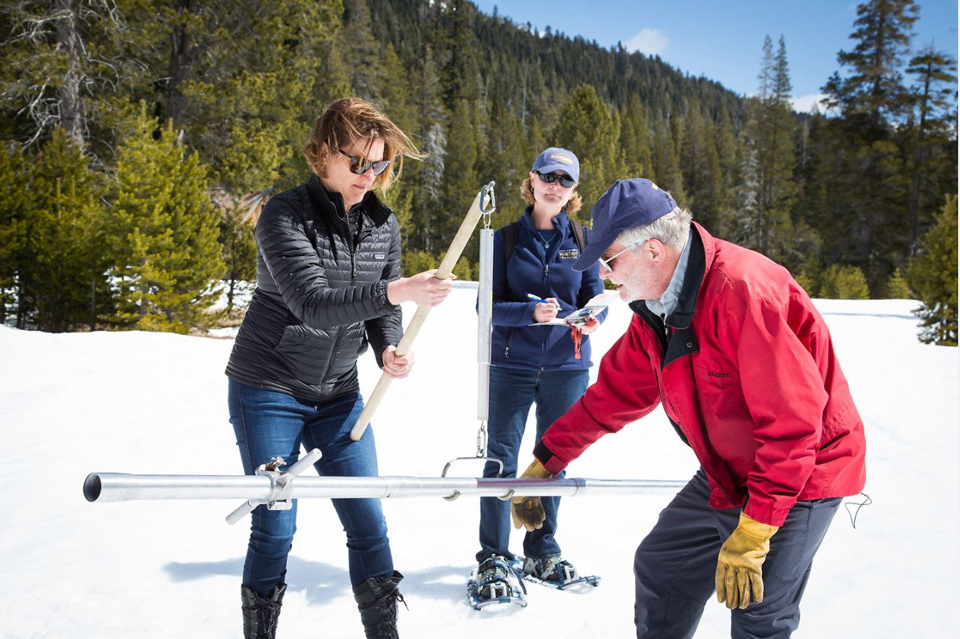
Karla Nemeth, Director of the California Department of Water Resources, left, Cindy Messer, Chief Deputy Director (DWR), center, assists Frank Gehrke, Chief of the California Cooperative Snow Surveys Program, with the fourth snow survey of 2018 at Phillips Station in the Sierra Nevada Mountains. The survey site is approximately 90 miles east of Sacramento off Highway 50 in El Dorado County. Photo taken April 2, 2018.
Credit: Dale Kolke / California Department of Water Resources
April 2, 2018 - SACRAMENTO –– Following one of the driest Februaries in California history, late winter storms increased the Sierra Nevada snowpack but were not enough to put the state on track for an average year.
Today’s snow survey by the California Cooperative Snow Surveys Program indicates that water content in the statewide mountain snowpack increased from 23 percent of the March 1 average to 52 percent of today’s historical average. The early-April snow survey is the most important for water supply forecasting because the snowpack is normally at its peak before it begins to melt with rising spring temperatures.
“These snowpack results – while better than they were a few weeks ago – still underscore the need for widespread careful and wise use of our water supplies,” said California Department of Water Resources Director Karla Nemeth. “The only thing predictable about California’s climate is that it’s unpredictable. We need to make our water system more resilient so we’re prepared for the extreme fluctuations in our water system, especially in the face of climate change.”
The snow survey conducted at Phillips Station by Frank Gehrke, chief of the California Cooperative Snow Surveys Program, found a snow water equivalent (SWE) of 12.4 inches, or 49 percent of average for this time of year as recorded since 1964. SWE is the amount of water contained within the snowpack. The snowpack normally provides about a third of the water for California’s farms and communities as it melts in the spring and summer and fills reservoirs and rivers.
“Despite recent storms, today's snow survey shows that we're still playing catch-up when it comes to our statewide water supplies,” said Gehrke. “While today's snow survey determined that the water content is much higher than February, the state will remain well below average for the year.”
In addition to the manual surveys conducted at Phillips, DWR also logs electronic readings from 103 stations scattered throughout the Sierra. Electronic measurements indicate the SWE of the northern Sierra snowpack is 11.8 inches, 43 percent of the multi-decade average for today’s date. The central and southern Sierra readings are 17.6 inches (60 percent of average) and 12.9 inches (50 percent of average) respectively. Statewide, the snowpack’s SWE is 14.6 inches, or 52 percent of the April 2 average. Electronic snowpack readings are available on the Internet at: http://bit.ly/2rVa84a
The Phillips snow course, near the intersection of Highway 50 and Sierra-at-Tahoe Road, is one of approximately 260 that are surveyed manually throughout the winter. Manual measurements augment the electronic readings from the snow pillows in the Sierra Nevada that provide a current snapshot of the water content in the snowpack.
Results of the readings by DWR at Phillips Station and Tamarack Flat are as follows:

California’s exceptionally high precipitation last winter and spring resulted in above-average storage in 154 reservoirs tracked by the Department. DWR estimates total storage in these reservoirs at the end of March was 28.2 million acre-feet (MAF), or 107 percent of the 26.4 MAF average for this time of year.
Source: CA. DWR








